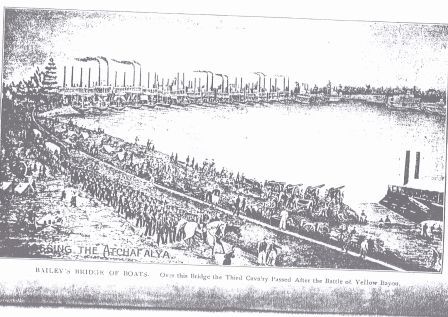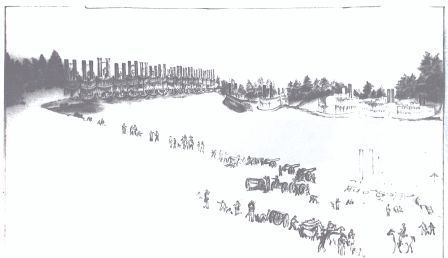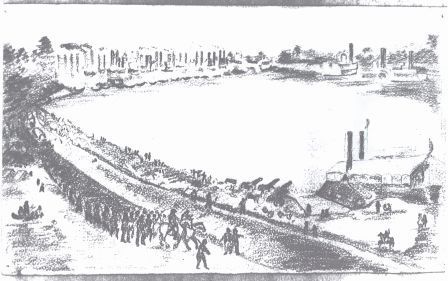Friends of Fort DeRussy, Inc.
The Official Site of Fort DeRussy, Louisiana

The Steamboat Bridge at Simmesport
May 18-
At the end of the Red River Campaign, the Union Army found itself up against the
banks of the Atchafalaya River at Simmesport. To facilitate crossing the river, an
unusual bridge of boats was built by using twenty-
A sketch of the bridge made its way into the regimental history of the 3rd Massachusetts Cavalry.
This sketch was done by John Needham Bellchamber of Co. C, 119th Illinois Infantry. Bellchamber made several sketches on site preliminary to this completed one. These sketches are currently in the possession of the Illinois State Historical Library, Springfield, Illinois, and are shown below:
This nearly complete sketch shows almost all of the detail that appears in the sketch in the Massachusetts book.
The picture above, but without the soldiers marching along the river bank.
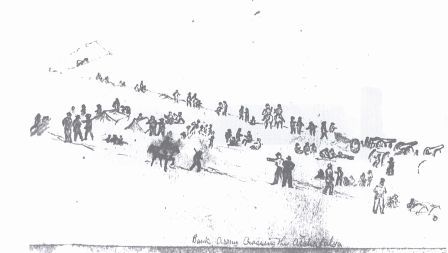
Soldiers on the riverbank, without any of the steamboats.
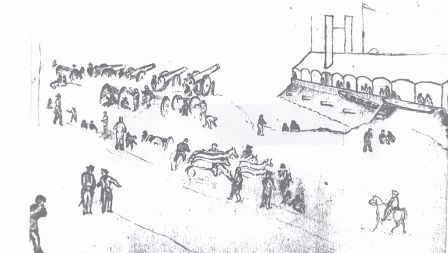
A detailed study of the gunboat Benton, and cannons on the riverbank placed to cover the far shore, or possibly just waiting to be moved.
All of these sketches were made from the east bank of the Atchafalaya River, across from the town of Simmesport.
Below are some of the numerous accounts of the Steamboat Bridge.
NOTE: In some instances, you will see reference to the Atchafalaya River being 600 yards wide at this point. The actual distance was around 600 feet.
"The 16th of May we reached Simsport, on the Atchafalaya. Being entirely destitute
of any ordinary bridge material for the passage of this river (about 600 yards wide)
a bridge was constructed of the steamers, under direction of Lieutenant-
Banks, Nathaniel. Report. The War of the Rebellion: A Compilation of the Official Records of the Union and Confederate Armies. Volume 34, Part 1. Washington. 1891. Page 212.
"Early on the morning of the 19th, the army commenced to cross the Atchafalaya, a portion, with all the train, moving over upon a bridge of steamboats, which was another product of the engineering skill of Lieutenant Colonel Bailey. The structure consisted of twenty transports, anchored abreast of each other, from bank to bank. Over their decks, timbers and planks completed a bridge of nearly fifteen hundred feet in length. About the middle of the forenoon, the One Hundred and Fourteenth was ferried over on the steamer Emerald . . . "
Beecher, Harris H. Record of the 114th Regiment, NYSV. Norwich, N. Y.: J. F. Hubbard, Jr. 1866. Page 356.
"The advance under Gen. Banks, having arrived at Semmesport, and there being no bridge
over the Atchafalaya, Lieu't. Col. Bailey (who built the dam at Alexandria), at once
proceeded to improvise a bridge from the transports, which had also arrived there.
The river at that point is about one third of a mile in width. Transports, sufficient
in number to span the river, were placed side by side, and fastened together by ropes,
&c., and across their decks, the army marched. This "bridge" was finished on the
19th, and the advance passed over that afternoon. In the meantime, -
I can not speak of this battle from personal experience, as I was not in it, having been with Gen. Smith at Semmesport, witnessing the building of the "bridge of boats." Word did not reach us that there was fighting until nearly dark, the sound of artillery &c., having been deadened by the noise of bridge building, although once or twice we thought we heard artillery firing.
Gen. Smith's troops remained at Yellow Bayou during the 19th, while the "Army of the Gulf" crossed the Atchafalaya, and on the 20th, the "Army of the Tennessee" crossed over, after which the bridge dissolved into boats again, and started for the Mississippi River to meet us."
Burns, William S., Scrapbook. Schoff Civil War Collection, Clements Library, University of Michigan, Ann Arbor, Michigan. Page 60.
"They [the fleet of transports] were all river steamers, and getting alongside each other, with their stems up stream, they formed a bridge which answered the purpose nicely. All our large wagon train and artillery had to be run over by hand. Hour after hour we worked until at last every army wagon, gun, caisson, forge, mule, horse and man, were across the stream, and in a very short time the bridge had dissolved into distinct bodies, which ascending the Atchafalaya, were soon at the mouth of the Red River."
Clark, Orton S. The 116th Regiment of New York Volunteers. Buffalo: Printing House
of Mathews and Warren. 1868. Pages 181-
"Fri. May 20 64 about 1 o'clock PM we crossed the bayou or river on the bridge made by the transports being placed alongside of each other and plank put across the bows"
Dawes, Frances A. Diary, 1862-
"The Third Cavalry buried its dead, recovered its wounded, and, on the night of the
20th of May, 1864, over a bridge of twenty-
Ewer, James K. The Third Massachusetts Cavalry in the War for the Union. Boston: Historical Committee of the Regimental Association. 1903. Page 185.
"Our next camp was at Simmsport on the Atchafalaya River. . . . A bridge across this
river was made by placing together the bows of twenty-
Fairbanks, Henry N. "The Red River Expedition of 1864," in War Papers, Maine MOLLUS, Vol. I. Portland, Me. 1898. Page 190.
"There was no bridge over this bayou [Atchafalaya River], so the gun boats and attendant boats formed a bridge by placing the bow of the boats on the same line, taking timbers from houses and barns and stretching them across. The army passed over; then the boats formed in line for passage down the river."
Foster, Jacob T. Memoirs. State Historical Society of Wisconsin. Microfilm copy at ULL Library, Lafayette, Louisiana. (1st Wisc. Batty.) Page 67.
". . . we were ordered to cross the river. Now the Atchafalaya was very much too wide (600 yards or more) for our pontoon bridge, so Col. Bailey put a dozen or more steamboats abreast of each other, and some of our regiment went over on this bridge, and the others were ferried over on the steamer Marmora."
Gould, John M. History of the First-
"On the 19th and 20th the army and its artillery and trains crossed the Atchafalaya at Simsport, on a bridge of pontoons, transports and log a third of a mile long."
Hall, Henry, and James Hall. Cayuga in the Field. A Record of the 19th N.Y. Volunteers, all the Batteries of the 3d New York Artillery, and 75th New York Volunteers. Auburn. 1873. Page 190.
"Colonel Bailey was called into service again at the Atchafalaya to construct a bridge
for the passage of troops over the bayou, which was swollen, and now between 600
and 700 feet wide. Twenty-
At four o'clock on the morning of the 18th, the 128th returned from the picket line,
and at eight, crossed over this novel bridge, and marched two miles out and bivouacked
in a corn-
Hanaburgh, D. H. History of the Hundred and Twenty-
"The pontoon was laid on steamers anchored close together. String pieces were bolted down across the decks, and, upon them, a floor of the flat cypress rails of the country was laid. It made a good bridge, but exceedingly crooked from the unequal height and length of the boats. Wagon, mules and men crossed on it. The artillery was ferried over. On both banks of the bayou, graves were dug for the dead of the day of the fight."
History of the Forty-
"May 18 . . . at work building a bridge of 25 steamboats, bows on alternate, details of brigades at work night and day running trains across by hand.
May 19. Our brigade on detail to run artillery and wagons across, finished to-
May 20. The rear of the army are across . . . "
History of the Second Battalion, Duryee Zouaves. New York: Peter de Baun and Co. 1904. (165th N. Y. Inf.) Page 30.
"We crossed the Atchafalaya by a novel bridge constructed of steamboats. This, too,
was Bailey's work. He anchored them side by side, the bows level with each other,
and placed planks across them. The whole army, with its baggage-
Hoffman, Wickman. Camp Court and Siege: A Narrative of Personal Adventure and Observation During Two Wars. New York: Harper & Brothers. 1877. Page 103.
"At Simmesport the skill and readiness of Bailey were once more put to good use in
improvising a bridge of steamboats across the Atchafalaya. In his report Banks speaks
of this as the first attempt of the kind, probably forgetting, since it did not fall
under his personal observation, that when the army moved on Port Hudson the year
before, the last of the troops and trains crossed the river at the same place in
substantially the same way. However, the Atchafalaya was then low: It was now swollen
to a width of six hundred or seven hundred yards by the back water from the Mississippi,
and thus the floating bridge, which the year before was made by lashing together
not more than nine boats, with their gangways in line, connected by means of the
gangplanks and rough boards, now required twenty-
On the 20th A. J. Smith crossed, the bridge was broken up, and in the evening the whole army marched for the Mississippi."
Irwin, Richard B. History of the Nineteenth Army Corps. New York: G. P. Putnam's
Sons. 1893. Pages 346-
"May 18th. Immediately after reaching this place [Simmesport] we disembarked and commenced assisting in the construction of a bridge across the river by placing the transports side by side, with their gang plank laid across their bows, we soon had a bridge constructed ready for General Bank's army to cross. It consists of nineteen large transports, some of them are the Metropolitan, Colonel Cowls, Ohio Bell, Star Light, Black Hawk, Madison, South Western, Rob Roy, Sally Robinson. The army commenced crossing as soon as the bridge was ready. Bank's army was vigorously pressed by the enemy, and only General A. J. Smith's troops stood between them and destruction.
On the 20th, I am on duty on the bridge, where I can witness the great panorama as it passes in my view. The Nineteenth Corps passed yesterday and last night, the Thirteenth Corps is passing today and will consume the most of the coming night. There are some cavalry. They will come later, will probably be the last. The troops look dusty and worn, tired and ragged. General Banks looks dejected and worn, and is hooted at by his men. Gen. A. J. Smith's men look weary and tired, but alert and confident. The roar of battle has followed them till their feet are on the bridge. Artillery and sharpshooters are placed along the banks of the river on the east so the Confederates dare not come close enough to interrupt the crossing. We also have gunboats on the river, grim sentinels that carry conviction and confusion."
Jones, S[amuel] C. Reminiscences of the Twenty-
" . . . we arrived that day at Simmesport, on the Atchafalaya River, which we crossed on the 19th, partly by means of transports, and partly by a bridge made of twenty steamboats fastened together side by side."
Jones, William E. The Military History of the One-
"May 19th the regiment was ferried across the Atchafalaya on the steamer Marmora,
marched about half a mile and went into camp again. Near where we crossed was one
of the largest pontoon bridges built during the war. It was composed of twenty-
Lufkin, E. B. History of the Maine Thirteenth. Bridgton, Me. 1898. Page 93.
"We were now drawing near the Atchafalaya, which, at this season of the year was an outlet of the Mississippi and, in consequence of the high water, was a formidable stream.
Kirby Smith [Confederate commanding general] thought now he had us, as he reasoned when we had ferried half of our army across, and they could not assist he would surely gather in all on the West side. . . .
But this deep, wide and swift stream was to be crossed, and had we used our boats for ferrying, the result would have been different in all probability. This is where Yankee ingenuity came in again.
We had plenty of steamboats, using twenty-
A steady stream of men, teams, wagons and artillery kept moving for three day and nights and Kirby Smith was cheated.
The Eighty-
Marshall, T. B. History of the Eighty-
"May 19th . . . No bridge, but Col. Bailey is equal to the occasion once more, and
has lashed twenty-
Merwin, John W. Roster and Monograph 161st Reg't, N. Y. S. Volunteer Infantry. Elmira: Gazette Print. 1902. Page 130.
"When we arrived at that stream [the Atchafalaya, May 20], we found the boats there,
and nineteen of them formed into a pontoon bridge, they were anchored side by side
and a road-
Newsome, Edmund. Experience in the War of the Great Rebellion. Carbondale, Ill.: published by author. 1879. (81st Ill.) Page 83.
"Thursday, May 19 . . . I was sent back with the teams to help cross the Atchafalaya Bayou on a pontoon bridge made of 20 steamers.
Friday, May 20. Commenced crossing over our teams at 8 am. . . . troops all crossed over and boats started."
Parmenter, Almon W., ed. by Sally K. Moore. Civil War Diaries of Pvt. Almon Wilson Parmenter. San Jose, CA. 1994. (Co. C, 32d Iowa Volunteer Infantry) Page 35.
"The bayou was wide at this point where the road came to it and the engineers were called upon to improvise a bridge. This was put together with barges pieced out with certain of the transports, and when the last brigade with its impedimenta had crossed over, the westward end was cut loose and the column of boats swung down the stream and was hauled in on the Mississippi side. The final operation was, I was told (we were again in the advance), enlivened by some sharp battery practice from the Rebel side of the bayou, but this did not prevent the programme of the engineers from being carried out successfully."
Putnam, George H. Memories of my Youth, 1844-
"The Atchafalaya was bridged by lashing twenty-
Reid, Whitelaw. Ohio in the War: Her Statesmen, Her Generals, and Soldiers. Volume II: The History of her Regiments... Cincinnati: Moore, Wilstach & Baldwin. 1868. Page 483.
" . . . we started on our way to the river and marched all day and night and came
to Bayou, Louisiana Chapiellie again and we must cross the Bayou and, having no pontoons,
they make a bridge of the points of the boats, by anchoring the steam boats side
by side and laying a floor with timber taken from cotton gins and the near-
When on the other side of the Bayou, and the boats slip their anchors and go their way to the Mississippi River, we march across and embark to go to Memphis and join General Sherman in his campaign to the sea."
Roberts, Jobe M. The Experience of a Private in the Civil War. Sylvan Beach, N. Y. 1904. Page 41.
"I cannot speak of this battle [Yellow Bayou] from personal experience, as I was with General Smith at Simmsport, witnessing the building of the 'bridge of boats'. Word did not reach us that there was fighting until nearly dark, the sound of artillery etc., having been deadened by the noise of bridge building, although once or twice we thought we heard artillery firing."
" . . . on the 20th the Army of the Tennessee crossed over, after which the bridge dissolved into boats again, . . ."
"On the forenoon of the 18th, the fleet of transports, lying in the Atchafalaya at Simmsport, were shoved in side by side until they filled the stream from bank to bank, and then they were tightly bound together by ropes, and thus their bows made a complete bridge. The stream here is about one hundred rods wide, with almost perpendicular banks. On this pontoon of boats the troops and trains marched over. The Nineteenth corps crossed while the troops of Smith were engaged in the battle of Yellow Bayou. The rear guard did not cross until the 20th, and at 4:30 p. m., the bridge of boats was torn up, and the fleet moved up stream. The Red River campaign was ended."
Scott, John. Story of the Thirty Second Regiment Iowa Volunteers. Nevada, Iowa. 1896.
Pages 259-
"May 18, 1864. . . Built a bridge by anchoring steam boats along side each other and laying on planks. It took twenty steamboats to reach across.
May 19, 1864. . . marched back toward the landing, and found the whole army crossing on the bridge of steamboats."
Smith, George G. Leaves from A Soldier's Diary. Putnam, Conn.: G. G. Smith. 1906. (1st La. Inf. Vol. {White}) Page 120.
"At one o'clock we moved across the Atchafalaya on a magnificent bridge of twenty large steamboats, lying side by side. Another such bridge this country has rarely if ever seen."
Sprague, Homer B. History of the 13th Infantry Regiment of Connecticut Volunteers during the Great Rebellion. Hartford: Case, Lockwood & Co. 1867. Page 214.
"We reached the vicinity of Simsport on the 16th . . . Our boats being there, a bridge was made of them across the Atchafalaya, and on the 17th, 18th, and 19th the Thirteenth and Nineteenth Corps and the cavalry crossed the bayou."
"[We crossed] at daylight [on the 19th] on a bridge which was the result of the genius
and skill of the officer who saved the ironclads at Alexandria, viz., Lieut.-
Stanyan, John M. A History of the Eighth Regiment of New Hampshire Volunteers. Concord, N. H.: Ira C. Evans Printer. 1892. Pages 478, 481.
"May 18th at noon we were ferried over the Atchafalaya by transports, while the artillery,
cavalry, and wagons crossed on an extraordinary and novel bridge, suggested by Lieutenant-
Tiemann, W. F. The 159th New York Infantry in the War of the Rebellion. Brooklyn: 1891. Page 77.
"Simmsport is on the Atchafalaya River, and the same Colonel Bailey who planned the
dam at Alexandria had built a bridge of boats for us to cross over. Twenty-
Van Alstyne, Lawrence. Diary of An Enlisted Man. New Haven, Conn.: The Tuttle, Morehouse & Taylor Company. 1910. Page 329.
"May 19 -
Whipple, Henry P. The Diary of a Private Soldier. Waterloo, Wisc. 1906. (29th Wisc. Inf.) Page 46.
"we . . . reached Simsport on the 17th, where a deep stream, six hundred yards wide,
rushed before us at the rate of twelve to fifteen miles per hour. There was no bridge,
and we had no material out of which to construct one of sufficient length. Here we
were again indebted to the ready western genius of Lieut.-
Woods, J. T. Services of the Ninety-
This information was compiled by Steve Mayeux, Longbridge, La., 1995
